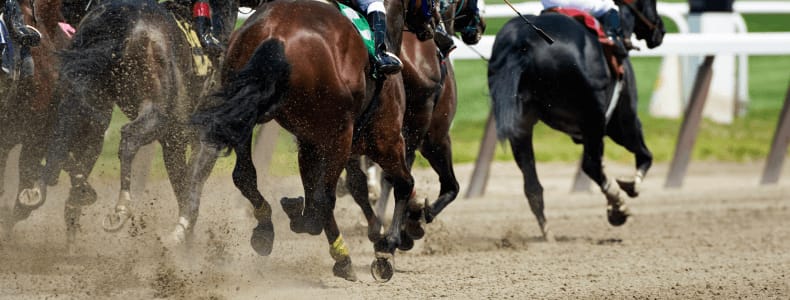
There are many sorts of punters who enjoy a plunge on Thoroughbred racing.
There is the sort who come out for the Melbourne Cup and never bet again until the next Melbourne Cup.
There are the sorts who, while staring at their mobile waiting for their ride-hail to come along, look past their screens at their feet and see Sir John’s moustachioed mug staring up at them, grab the note and plonk it down on the next race.
At the opposite end of the spectrum are the punters who are in it for a source of income.
We are aiming somewhere in between. For the punters who want to build their racing punting skills and participate on a regular basis, whether that basis is the metro carnivals, the country tracks, or some combination, we have prepared this list to aid in developing a consistent winning strategy.
1. Always Wager With Money That You Can Afford to Lose
Abandon those glossy-eyed dreams of sweeping a meeting and routinely picking long priced runners.
When we say to punt with money you can afford to lose, the reason behind this is that you will make better decisions when you are free of any psychological pressure to win in order to cover the rent or any other financial obligation.
All of the online bookies offer members a chance to establish all manner of betting limits. You may not need this, but it is a good idea to establish your bank in advance. Any limits set can always be revisited later and revised upwards or downwards. A bit of caution at the outset is worth 50 future regrets.
2. Set a Limit on the Amount you are Willing to Bet on any one Race
This ties in with the first tip. Again, the online bookies will allow you to set this per-race limit, but this is an amount of money you should think about carefully. A basic rule of thumb is to keep any wagers in a race to two percent or less of your wagering fund.
If you set up a bookie membership with $1,000, never bet more than $20 on a single race. With the ludicrously low minimum wagers most of the bookies offer, you can have 20 punts on one race without exceeding the two percent/$20-race limit.
Note: We are not saying you should have 20 punts on one race, but simply that you could without threatening to exceed a $20 limit.
3. Expect to Spend Some Time Evaluating the Runners in a Race
Statistics assembled over decades of racing and thousands of races indicate that a favourite will win about 1/3rd of the time. A one-in-three chance before a race sounds pretty fair, but it is the other 2/3rds that supply a lot of room for other outcomes, not to mention a vast hole in which to throw your money.
You want to take the time to examine a favourite in the hopes of developing an impression if the top-line quote represents a solid selection, could be vulnerable for any number of reasons, or is outright false.
There will be many instances where the favourite is very likely to win, but the quote is so short that the dividend is barely beyond the costs of the bookie’s margin.
Taken from that perspective, it might be a good idea to simply abandon that race, or add other punts that will supplement a skinny dividend from a favourite, or supply some hedging factors in the event a favourite fails to fire for some reason.

4. Develop Some Ability to Understand and Use the Form
Learning to handicap a race field based on recent results, how certain horse fares when going up against another, track conditions, field size, distance and many other variables is a valuable skill to possess, even if it starts out low and rises with experience.
It might prevent you from backing the wrong horse.
Remember, you cannot lose a punt on a race where you are not involved with a wager. If it should turn out that a race you decided to sit out would have earned you a respectable heap of cash, do not fret.
There will be another race and another and another….
5. Give Some Thought to the Racing Strategy that any Particular Race Might Entail
If there are horses that have to go out on the speed and hope to hold off the kickers, how has that horse fared when following that strategy? If a field is large, say 12 or more, will those horses that play position for the last 200-metres have space to mount a late charge?
One of the best criteria for this tip is to look at a horse’s history from different barriers. If the horse is a tight turner, it is okay to draw the rail in most, not all, instances. Starting wide, on the other hand, means a horse will have to cover more ground, take up a position near the back by crossing inside, and hope for some racing room to open up.
A runner that can cover the extra ground at 1600-metres might fade if the trip is out to 1800-2000 metres.
There are experts who make a living considering all of these and more factors. Do not hesitate to factor their expertise into your selection decisions.
6. Have a Fairly Specific Plan for a Meeting
Never forget that the bookies have a plan. Their plan is reflected in the prices they quote. They are right more often than they are wrong, but even when they get one wrong and you capture a nice prize, the bookies are paying you with the money of the punters who could not be bothered to look at the races in advance.
Your plan should be equally thorough.
A typical carnival meeting will have 8 – 10 races. Half an hour the night before the meeting is the ideal time to check the fields and odds and possibly decide that there are three or four races that offer little of value.
If you rule out five races in a nine-race meeting, right there are five races that cannot hurt your bank.
Does that mean you should use the $100 you planned to allocate to those five races and increase your stake to $40 for the races you intend to punt?
We would not stop you, but by following this logic, you lose the advantage of not betting on poor races by risking the stakes you saved on the remaining four races.
Remember, racing punting is often a question of surviving to punt another day.
Remember also that the bookies’ edge is that they set the prices and they participate in every race, something like the edge the house enjoys with casino games.
Your planning should also include a strategy for spreading your risk around with all the different bet types the bookies offer, including win bets, each-way, exotics, eg Trifectas and multis.
7. It is Okay to Exult When You Win or Mourn When You Lose
So long as you stick to your strategy. One way to do this is to ignore those around you who offer unsolicited tips in order to influence your betting decisions. There is no one who knows the winners in advance, or which boxed trifecta is a sure thing. It would require only one person with this sort of knowledge to erase Thoroughbred race punting.
Remember, stick to your plan while you are at the track or filling out a bet slip online. You might need to fine-tune your strategy. You might need to toss some parts entirely. You will be gaining valuable experience along the way and your strategy will evolve, but let it evolve on Tuesday, not mid-meeting on a Saturday.

8. Do Not Chase Losses
If your selection was nipped at the post and your $20 gone into the bookie’s bag, do not up your stake to $40 for the third race. Chasing losses by increasing wagers is a recipe for disaster.
One suggestion we can offer as an example is to tell you to develop the mindset of a professional golfer. Pros get one chance to hit a shot. They have attained the mental discipline to forget a bad shot quickly and move on to the next shot. Likewise, their last shot may have been a beauty, but it means naught when it comes time to hit the next shot.
Conversely, when you win, do not succumb to the idea that you are invincible and increase your stakes. Giving money back this way is one of the worst possible feelings you can encounter.
Racing fate is always ready to smack down the arrogant.
Remain focused on the big picture, which is to win more money than you lose. If you strike gold on your first punt, a good path to follow would be to remove 80 percent of that win from play. Your bank instantly grows by 20 percent, which further eases any psychological pressure as you make your selections for subsequent races.
9. More Money Lost Than Won, Plan Needs to be Tweaked
Everyone enjoys having a routine. Habits are keystones of our daily lives, so it stands to reason that betting habits are reassurance that you are doing your best to deal with uncertainty.
The trouble with plans, routines and habits, however, are that they can snuff out creative thinking and if there were ever an activity that requires creativity and constant adaptation to the current reality, it is hard to think of a better one than race punting.
That horse that looks a sure thing on Friday evening might sour overnight when the track is inundated by 60 millimetres of rain.
Now, if your strategy planning was well thought out, you already have your backup selection ready to go, but if it has to wait until Saturday morning, that is okay.
The same applies if the $2.50 runner you picked on Friday has been backed off the map to $1.20. This is extreme, but it happens to many favourites. Some punters try to circumvent this reality by putting in wagers when the markets go up.
The flaw in that approach is that if a backed horse is scratched the day of the race, the cash is gone with most of the online bookies. In its place, there might be a bonus bet of equivalent value, but do not forget that real cash and bonus cash are not the same.
The flexibility to acknowledge that it is possible to do everything in your power correctly and yet, still lose is what makes punting so entertaining.
10. If You Are Not Having Fun, Stop Punting
This is where the first tip in this list again comes to the fore. It is hard to have fun when your first four punts get nipped. It is still a loss, whether by a nose or by four lengths.
Keep in mind that punting Thoroughbreds is often a streaky proposition. You might have a 60 percent strike rate, meaning that you make something from 60 races per 100.
The distribution of those 60 wins and those 40 losses is seldom orderly. There will be times when you encounter a streak that places your strike rate up around 80 percent, and other times when you could have backed Winx going for number 30, only to jinx her.
That is simply the nature of race punting and you need to be able to smile ruefully when you get on that rough patch where your winning strike rate drops to 30 percent and every galloper you back suddenly turns into Chautauqua and will not leave the barrier.
When you win, your smile will be broader, but when your smile disappears entirely and you are convince that Racing Victoria and Racing New South Wales are conspiring to take your money, it is time to step back and question why you are doing something for recreation that does not bring you enjoyment.







